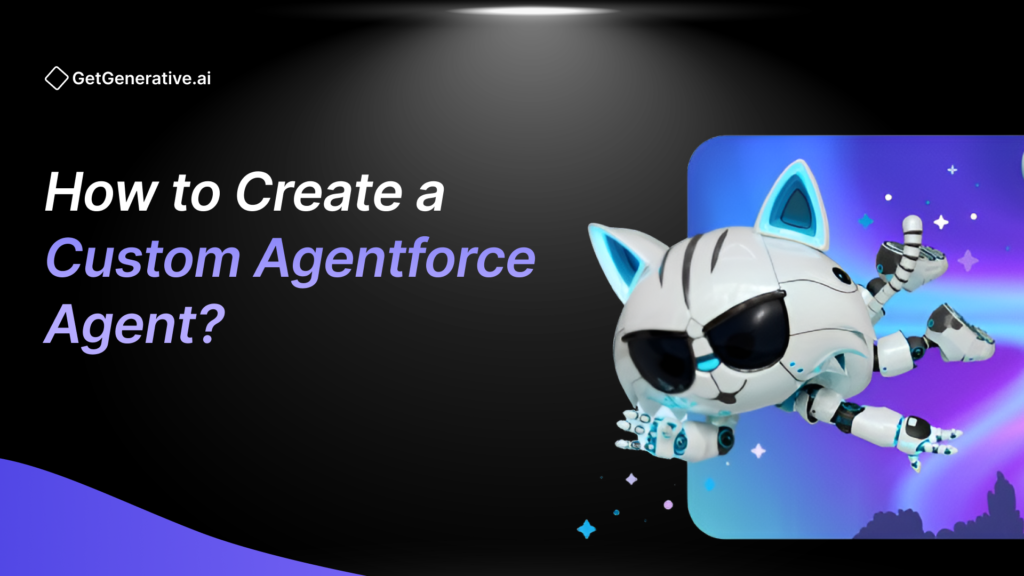How to Create a Custom Agentforce Agent?
Agentforce, Salesforce’s AI-powered conversational assistant, empowers businesses to automate interactions, streamline workflows, and deliver highly personalized services. Whether you’re looking to boost customer engagement or optimize internal processes, creating a custom Agentforce agent can be your game-changer.
In this guide, we’ll explore a detailed step-by-step approach to building your custom Agentforce agent, highlighting key tips, tools, and best practices along the way.
What is Agentforce?
Agentforce is Salesforce’s next-gen AI assistant platform that leverages Natural Language Processing (NLP) to create highly responsive and adaptive service agents. This intuitive low-code platform streamlines the creation of AI-powered agents, allowing businesses to deploy smart solutions with minimal programming effort. Whether it’s answering customer queries or executing backend workflows, Agentforce is designed to make every interaction seamless.
Prerequisites for Building a Custom Agentforce Agent
Before diving into the creation process, ensure the following requirements are met:
- Einstein Generative AI Org: This must be active within your Salesforce environment.
- Einstein Setup: Ensure this feature is enabled.
- Einstein Bot Activation: This toggle must be turned on for the agent to function.
Step-by-Step Guide to Creating a Custom Agentforce Agent
Step 1: Enable Einstein and Einstein Bots
- In Setup, use the Quick Find bar to search for “Einstein Setup.” Enable the Einstein Setup toggle.
- Next, search for “Einstein Bots” and enable the feature. This activates the core AI functionalities required for building Agentforce agents.
Step 2: Create a New Agent
- Search for “Agents” in the Quick Find bar and navigate to the Agentforce configuration page.
- Click on “New Agent” in the top-right corner to create a new custom agent.
- Assign a name and description to your agent for easy identification (e.g., “Customer Support Assistant”).
Step 3: Define Agent Behavior in the Builder
After creating the agent, click “Open in Builder” to start customizing its behavior. This step involves defining what the agent will do and how it will respond.
A. Setting Up Topics and Actions
- Topics: Define the primary topics your agent will handle, such as “Order Inquiries,” “Billing Support,” or “Appointment Scheduling.”
- Actions: Assign actions to each topic, such as retrieving customer details, creating bookings, or escalating issues to human agents.
B. Use Case Example:
For instance, if you’re building an agent for travel management, create a topic called “Travel Assistance” with actions like “View Itinerary,” “Cancel Booking,” and “Modify Reservation.”
Also Read – Salesforce Launches Agentforce Testing Center
Step 4: Add Customizations with Prompt Builder
Prompt Builder enables personalized interactions based on user data. Here’s how to enhance your agent’s conversational capabilities:
- Customize Prompts: Modify built-in prompt templates to reflect your business tone and style.
- Embed Prompts in Workflows: Link prompts to workflows, ensuring seamless transitions during customer interactions.
- Test Prompt Responses: Use test scenarios to ensure your prompts deliver relevant and accurate responses.
Step 5: Integrate Advanced AI Models
For agents handling complex tasks, leverage Model Builder to incorporate AI and machine learning models. This allows your agent to process sophisticated queries and provide intelligent insights.
- How to Integrate Models: Use Model Builder to register and activate Large Language Models (LLMs) or custom AI models.
- Test and Refine: Validate the model’s performance and refine it for optimal results before going live.
Step 6: Test and Validate the Agent
Testing is crucial to ensure the agent behaves as expected in real-world scenarios.
- Use the Agent Builder’s testing environment to simulate interactions.
- Run test cases to confirm the agent’s accuracy, speed, and efficiency.
- Refine workflows and responses based on testing feedback.
Step 7: Deploy Your Agent
Once your agent is ready, deploy it to customer-facing channels such as:
- Websites
- Mobile Apps
- Messaging Platforms (e.g., WhatsApp, Slack)
Use the embedded messaging component in Salesforce Experience Cloud to add your agent to web pages or apps. After deployment, monitor performance metrics like response time, accuracy, and user satisfaction.
Also Read – Salesforce’s Agentforce: What It Does and How It Works
Best Practices for Building Agentforce Agents
- Start Simple: Focus on a few key functionalities before expanding your agent’s capabilities.
- Enhancing User Experience: Craft agent responses to be straightforward, precise, and tailored to address user queries effectively.
- Continuous Improvement: Leverage data insights to pinpoint enhancement opportunities and refine your agent consistently.
Advantages of Custom Agentforce Agents
Increased Efficiency: Automate routine processes, enabling your team to concentrate on high-priority, strategic tasks.
Improved Customer Engagement: Personalized responses and real-time assistance create a seamless customer experience.
Scalability: Custom agents can easily scale with your business, handling higher volumes of interactions without compromising quality.
Conclusion
Creating a custom Agentforce agent empowers businesses to deliver tailored solutions, enhance user experiences, and streamline operations. With Salesforce’s intuitive tools like Agent Builder, Prompt Builder, and Model Builder, the process is straightforward and efficient.
To learn more, visit GetGenerative.ai.
FAQs
1. Do I need coding skills to build an Agentforce agent?
No! With Salesforce’s low-code tools like Agent Builder, you can create agents with minimal coding.
2. What channels can I deploy my Agentforce agent on?
You can deploy it on websites, mobile apps, and messaging platforms like WhatsApp or Slack.
3. How do I test my custom Agentforce agent?
Use the Agent Builder’s testing environment to simulate interactions and validate performance.
4. Can I integrate external AI models with Agentforce?
Yes, through Model Builder, you can incorporate third-party AI models for enhanced functionality.




